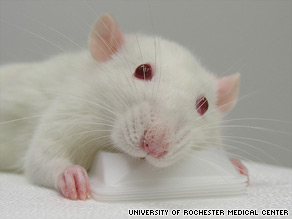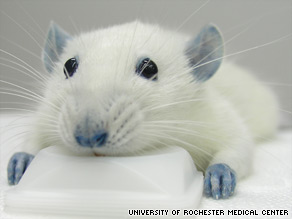A recent study by the University of Rochester Medical Center has found that the same chemical used to color blue M&Ms and blue Gatorade can also be used to heal spine injuries. The chemical, Brilliant Blue G (BGG) blocks P2X7, known as the “Death Receptor.” This stops the signal that tells motor neurons to undergo apoptosis (cell death). When rats with spinal cord injuries were injected with BGG, they were able to walk again with a limp.
How awesome is that?
And BGG has the added benefit of making rats extra adorable. They go from this: To this:
To this: Want. Now.
Want. Now.

Extra adorable until they dropped a weight on its back and then killed it to disect it :(
I support the research but it still makes me sad. I'm just glad I don't have to do it.
Extra adorable until they dropped a weight on its back and then killed it to disect it :(I support the research but it still makes me sad. I’m just glad I don’t have to do it.
How do you get them to pose like that? Do you have a little furry photographer?
…wait, did this article say Blue Gatorade cures paralysis?
How do you get them to pose like that? Do you have a little furry photographer?…wait, did this article say Blue Gatorade cures paralysis?
what is a blue human going to look like?
what is a blue human going to look like?
That is NOT more adorable! Pink rattie ears and noses and feetses are the most adorable things on the face of the planet. The blue just makes them look dead.
@Anon: It's a bit ridiculous, even in jest, to suggest that the researchers drop weights on the rats' backs. We're doing paralysis studies on guinea pigs at Purdue, and they surgically sever the spinal cord while the pig is under anesthesia.
That is NOT more adorable! Pink rattie ears and noses and feetses are the most adorable things on the face of the planet. The blue just makes them look dead.@Anon: It’s a bit ridiculous, even in jest, to suggest that the researchers drop weights on the rats’ backs. We’re doing paralysis studies on guinea pigs at Purdue, and they surgically sever the spinal cord while the pig is under anesthesia.
Or it makes the poor mouse look like a Libertarian on a colloidal silver binge.
Or it makes the poor mouse look like a Libertarian on a colloidal silver binge.
@ Julie
If you read the article in the National Geographic online it explicitly states that they drop weights on their backs. I didn't make it up.
@ Julie If you read the article in the National Geographic online it explicitly states that they drop weights on their backs. I didn’t make it up.
Thank you for calling me ridiculous, though! :D
"This rat (shown pre-treatment)had its spinal cord injured while under anesthesia (a weight was dropped on its back)and then recovered its ability to take clumsy steps 42 days after having been given a derivative of a common blue food coloring…"
http://news.nationalgeographic.com/news/2009/07/photogalleries/blue-rats-food-dye-heals-pictures/photo2.html
Thank you for calling me ridiculous, though! :D”This rat (shown pre-treatment)had its spinal cord injured while under anesthesia (a weight was dropped on its back)and then recovered its ability to take clumsy steps 42 days after having been given a derivative of a common blue food coloring…”http://news.nationalgeographic…
@Veritas : Looks like they are sedated and their heads are propped up, using three weigh boats as a "pillow". (Fisher Science p/n 08-732-112)
@Veritas : Looks like they are sedated and their heads are propped up, using three weigh boats as a “pillow”. (Fisher Science p/n 08-732-112)
Hmmm. Just looking at the picture (before reading the post) I flashed the idea that they were crossing rats with Hydrangeas, & wondered if playing with the PH of Purina Rat Chow allowed them to vary the coloration.
Hmmm. Just looking at the picture (before reading the post) I flashed the idea that they were crossing rats with Hydrangeas, & wondered if playing with the PH of Purina Rat Chow allowed them to vary the coloration.
In other rodent bio news: http://singularityhub.com/2009/07/30/growing-mice-from-stem-cells-the-real-story-about-the-stem-cell-breakthrough-from-qi-zhou/
In other rodent bio news: http://singularityhub.com/2009…
@Anon, I didn't call you ridiculous, so drop the persecution complex.
Forgive me for assuming that you were exaggerating, but I work in research. I have to deal with PETArds and ALF crazies every day making my job out to be some sort of gleefully malicious form of animal torture and abuse. They make up claims that sound much like yours did every day. There's an entire paralysis research center in my department, and I had never heard of such crude methods being used before. Surgical and acid-corosion methods are what we use.
@Anon, I didn’t call you ridiculous, so drop the persecution complex. Forgive me for assuming that you were exaggerating, but I work in research. I have to deal with PETArds and ALF crazies every day making my job out to be some sort of gleefully malicious form of animal torture and abuse. They make up claims that sound much like yours did every day. There’s an entire paralysis research center in my department, and I had never heard of such crude methods being used before. Surgical and acid-corosion methods are what we use.
Thats great but it still makes me sad that they had to give the rats a spinal cord injury =[
Thats great but it still makes me sad that they had to give the rats a spinal cord injury =[
YES! I knew the blue M&Ms were the best one! I just had to wait for scientific proof to catch up! I am SO going to start eating more M&Ms. [Serious time]Oh, and also, I’m glad that they can start to cure certain types of cancer. Really, I am. It’s the sort of thing that takes more lives every year than it ought to. [/Serious time]I’m not sure I’d want a blue rat though…that’s….actually a bit creepy. o.o;
That is rather awesome…
So why haven’t they found a cure or at least made some headway into solving types of cancer epidemic? Because they are all looking in the wrong place, there isn’t a cure for cancer where they are looking.
Most spinal cord injuries that involve negligence are the result of a car accident. The CDC attributes car accidents as the leading cause of spinal cord injuries in people under the age of 65. Many claims, however, do not go to trial. Instead, negotiation usually takes place with the liable party’s automobile insurance company.
In the future, diet, lifestyle, and dietary supplements will go beyond merely supporting and sustaining. These controllable factors will be viewed as significant complementary treatment techniques to reverse cancer. More funding is needed for researching integrative approaches.
Our present system primarily rewards those who can substantiate the performance of isolated synthetic drugs that can be patented. Research into combined approaches or utilizing a healthy diet, positive lifestyle choices, and supplements, all of which cannot be patented, is presently not being supported as much as it could be, or should be.
Today after spending billions of dollars in research are we any closer to solving the problem? Our current treatments are still only the same surgery, radiation and chemotherapy and very little else. Surgery is essentially akin to pulling weeds out of a garden. It doesn’t deal with what caused the cancer to grow in the first place or addresses how to prevent it from growing again in the future.
Cancer is exactly the same, it’s caused by a weak immune system, which is the human bodies natural defense system and has been weaken by the way we live. We don’t have drugs to boost the immune system so the only way to cure the cancer problem successfully is a natural way and that is to eat the foods that boost the immune system and remove from your lifestyle factors that weaken the immune system.
The solution to our cancer problem is to abandon our faith in modern medicine, which for all its science is still only a helpless bystander when it comes to curing cancer and to address the underlying cause of the problem which is mainly our addiction to the foods that stimulate, but do nothing towards nourishing the human body.